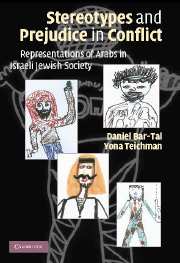Book contents
- Frontmatter
- Contents
- List of Tables
- List of Drawings
- List of Figures
- Preface
- Stereotypes and Prejudice in Conflict
- Introduction
- 1 The Psychological Basis of Intergroup Relations
- 2 Psychological Intergroup Repertoire in Intractable Conflicts
- 3 The Context: The Arab-Israeli Intractable Conflict
- 4 Representation of Arabs in Public Discourse
- 5 Representation of Arabs in School Textbooks
- 6 Representation of Arabs in Cultural Products
- 7 Representation of Arabs by Israeli Jews: Review of Empirical Research
- 8 The Development of Shared Psychological Intergroup Repertoire in a Conflict: Theory and Methods
- 9 Studies with Preschoolers
- 10 Studies with Schoolchildren, Adolescents, and Young Adults
- 11 The Reflection of Social Images in Human Figure Drawing
- 12 Conclusions and Implications
- References
- Index
5 - Representation of Arabs in School Textbooks
Published online by Cambridge University Press: 24 July 2009
- Frontmatter
- Contents
- List of Tables
- List of Drawings
- List of Figures
- Preface
- Stereotypes and Prejudice in Conflict
- Introduction
- 1 The Psychological Basis of Intergroup Relations
- 2 Psychological Intergroup Repertoire in Intractable Conflicts
- 3 The Context: The Arab-Israeli Intractable Conflict
- 4 Representation of Arabs in Public Discourse
- 5 Representation of Arabs in School Textbooks
- 6 Representation of Arabs in Cultural Products
- 7 Representation of Arabs by Israeli Jews: Review of Empirical Research
- 8 The Development of Shared Psychological Intergroup Repertoire in a Conflict: Theory and Methods
- 9 Studies with Preschoolers
- 10 Studies with Schoolchildren, Adolescents, and Young Adults
- 11 The Reflection of Social Images in Human Figure Drawing
- 12 Conclusions and Implications
- References
- Index
Summary
The examination of the presentations of Arabs in educational materials, specifically school textbooks, is of special importance for several reasons. First, school textbooks provide an excellent illustration of institutionalized societal beliefs, especially in democratic societies. They constitute a formal expression of a society's ideology, ethos, values, goals, myths, and beliefs that the society considers to be important requisites for the social functioning of new generations (Apple, 1979; Bourdieu, 1973; Luke, 1988). In the view of Luke (1988), school textbooks “act as the interface between the officially state-adopted and sanctioned knowledge of the culture, and the learner. Like all texts, school textbooks remain potentially agents of mass enlightenment and/or social control” (p. 69).
The implication is that school textbooks do not provide neutral knowledge but construct a particular social reality. They reflect a specific selection of material: particular descriptions, views, explanations, and interpretations that surface in a variety of subject matters but especially in those appearing in the textbooks of language, literature, history, geography, religious studies, civic studies, and social sciences. The contents of these subjects reflect the particular narrative, views, and emphases of a given society on a variety of issues that preoccupy it. According to Apple and Christian-Smith (1991), “Texts are really messages about the future. As part of a curriculum they participate in no less than the organized knowledge system of society. They participate in creating what a society has recognized as legitimate and truthful.
- Type
- Chapter
- Information
- Stereotypes and Prejudice in ConflictRepresentations of Arabs in Israeli Jewish Society, pp. 157 - 176Publisher: Cambridge University PressPrint publication year: 2005



